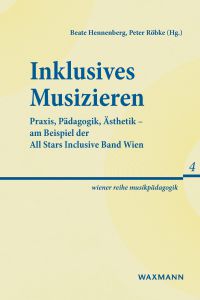Hennenberg, Beate and Röbke, Peter (eds.): Inklusives Musizieren. Praxis, Pädagogik, Ästhetik am Beispiel der All Stars Inclusive Band Wien. [Inclusive Music-Making. Practice, Pedagogy, and Aesthetics as Exemplified by the All Stars Inclusive Band, Vienna.] wiener reihe musikpädagogik, vol. 4

The newly released fourth volume of the Viennese music education-related publication series wiener reihe musikpädagogik revolves around inclusive music-making in all its breadth, covering its practical, pedagogical, and aesthetic dimensions including actual music-making practice. A prominent Viennese example in this regard is the mdw’s All Stars Inclusive Band, which was founded in 2010 and also served as the catalyst and starting point of this publication. As an incubator of sorts when it comes to inclusive musical practices at the University, this ensemble embodies a setting for research, practice, and experience—not just for students and faculty, but above all for people with and without disabilities who have a desire to make music. Many of the contributions to this volume hence refer to work with this band and research connected therewith as well as to its members’ experiences. With the All Stars Inclusive Band, the mdw has done pioneering work in Austria and thus positioned itself at the forefront of Austrian arts universities where inclusive and diversity-sensitive musical practice is concerned, winning prominent awards along the way.
These achievements are reflected in this multifaceted volume’s eight chapters, the first of which addresses “Inclusion, Humanism, and the Liberalism of Fear” and contains two central reflective contributions by the mdw music education professors Christoph Khittl and Peter Röbke. Khittl’s essay contains a plea for humanity as the basis for inclusion—which, according to Khittl, is imaginable only in the plural. Röbke, for his part, asserts that collective music-making involving vulnerable groups must always go beyond selecting appropriate music-related offerings to also include activities that do justice to political dimensions. His is a stance that runs throughout this collected volume.
There follows a chapter on the All Stars Inclusive Band, its development, and the associated research. Discussion here is also devoted to the social solidarity between the band’s members, which is reflected in the songs composed by and for the band and finds expression in the songs’ lyrics. The band has come to embody not only a realm of experience and practice but also a practically oriented setting for future instrumental and voice educators’ professionalisation. A further chapter likewise deals with professionalisation and with a type of training that includes inclusion-related competencies, following which further contributions address a diverse range of interesting didactic aspects and best practice examples. This collected volume is rounded out by contributions from various other areas of the music education field such as elementary music education, improvisation, and the audience engagement speciality known as Musikvermittlung. To anyone with an interest in inclusion, this collected volume offers well-founded considerations and inspiring looks into various fields of action as well as best practices for inclusive music-related endeavours outside of school settings.

